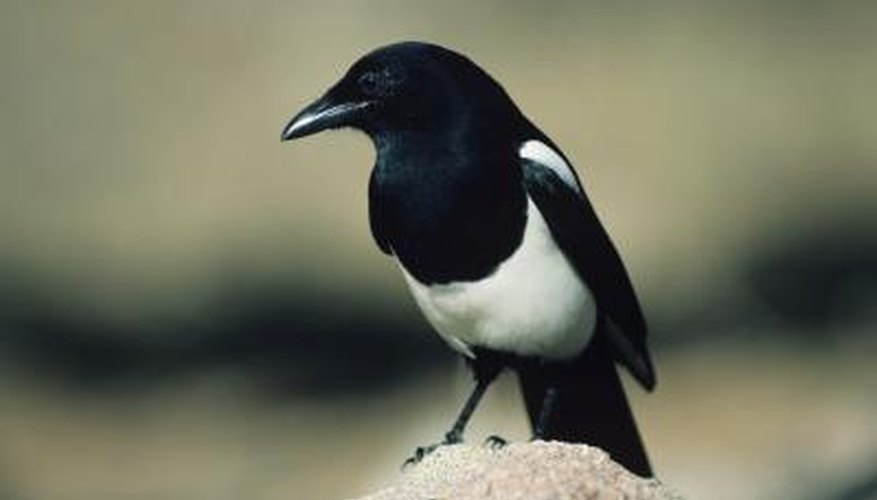Magpies are characterised by a bold black-and-white pattern, or "saddle," of colour on their bodies and long tails. Found in urban and rural areas of North America, magpies also inhabit the British Isles, Portugal, Korea, North Africa, Canada, Southeast Asia and Siberia. Although magpies are considered attractive birds due to their bold colour patterns, many people view them unfavourably because of their reputation as predators.
Differences in Appearance Between Male and Female Magpies

The most noticeable physical difference between male and female magpies is the colouration of the white hoods located on their necks and the backs of their heads. On male magpies, the hood is a vibrant white throughout; the hood on female magpies is greyish toward the bottom. When observed from a distance, especially if their heads are up, male and female magpies may appear indistinguishable. The colour of the hoods also differs in juvenile magpies: male juveniles have a brown/beige hood that is lighter in colour than the dark brown hood of a juvenile female.
- The most noticeable physical difference between male and female magpies is the colouration of the white hoods located on their necks and the backs of their heads.
- The colour of the hoods also differs in juvenile magpies: male juveniles have a brown/beige hood that is lighter in colour than the dark brown hood of a juvenile female.
Behavioural Differences
Magpie pairs remain together for life. Although both the male and female magpie work together to construct their nest, only the female incubates the eggs. It can take a pair of magpies up to 40 days to build a large nest, which usually takes the form of a dome made of mud, sticks and grass. The male provides food for the female while she incubates the eggs, and both share responsibility for the care and feeding of the baby birds.
- Magpie pairs remain together for life.
- The male provides food for the female while she incubates the eggs, and both share responsibility for the care and feeding of the baby birds.
Diet
There is no discernible difference between the diet of male and female magpies. Because magpies are omnivorous, they consume a wide variety of foods, including fruit, grain, mice, insects, acorns, snails and even other small birds. They have also been known to catch and feed on lizards, snakes, bats and frogs. Magpies are not very discerning in terms of what they eat; for this reason, they are sometimes regarded as unwelcome predators. In folklore, magpies are portrayed as having an affinity for shiny objects, such as rings and trinkets, which they swoop down on and steal.
- There is no discernible difference between the diet of male and female magpies.
- Magpies are not very discerning in terms of what they eat; for this reason, they are sometimes regarded as unwelcome predators.
Habitat

Male and female magpies can survive in both rural and urban areas, although they prefer open fields with trees and woodlands. They are often found in grasslands, meadows, sagebrush and thickets, which offer shelter as well as areas for nest building. Although magpies have been known to inhabit highly populated places, they tend to become nervous around humans and fly quickly and quietly away if someone gets too close.
